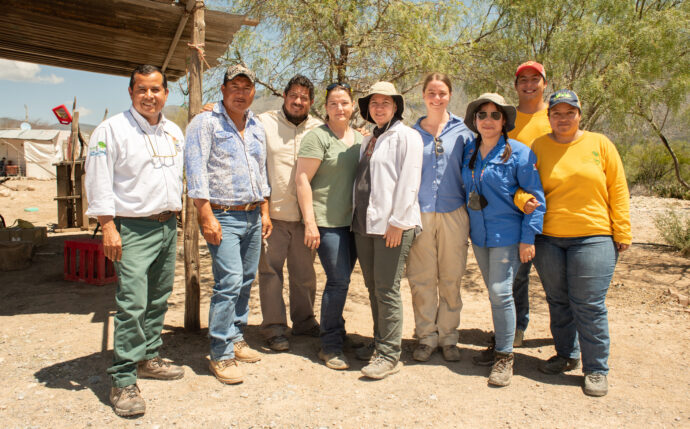
Insights and reflections from Bat Conservation International’s Agave Restoration Initiative, a bi-national landscape-scale initiative to save biodiversity and support rural livelihoods
By Kristen Lear, Ph.D., Agave Restoration Program Director, Bat Conservation InternationalNovember 2020. It’s been a long day of field work and a rough day of brutal facts. We’re finding fewer and fewer Mexican long-nosed bats in their only known mating roost, a cave in the foothills near Mexico City. In the spring, as diminished numbers of female bats leave the cave to begin their northward migratory journey to give birth, their survival will be threatened by the continuing loss and fragmentation of their primary nectar source: agave plants. We know we must move quickly, on a large landscape scale, to save these endangered bats from extinction.
* * * *
Bats have remarkably evolved over millions of years into the only mammals capable of wing-powered flight, some with sophisticated echolocation to fly through the night, and with highly adapted features for their environs on all continents except Antarctica. Bats matter. Healthy ecosystems, over millions of years, have depended on bats to pollinate plants, disperse seeds, and consume insect pests. Today – with the impacts of climate change, encroaching land development, and a host of other factors – the survival of hundreds of bat species around the world is in peril.
From central Mexico north into the American Southwest, three species of nectar-feeding bats have suffered population declines due to roost disturbance and the diminishing loss of their food plants, particularly agaves (Agave spp.), keystone species in desert and montane ecosystems. Agaves, in turn, depend on the bats for pollination to maintain healthy, genetically diverse populations that can adapt and overcome changing environmental conditions. Loss of bats means diminished numbers of agaves which means diminished foraging resources. It’s a heartless cycle.
In Mexico and the American Southwest, decreasing bat populations = loss of keystone plants
In the vast and arid landscapes of Mexico and the American Southwest, agaves are vital to stabilizing soil and controlling erosion, ultimately contributing to healthy waterways. Moreover, agaves have a long ethnobotanical history in religion and culture. Today, agaves are important resources cultivated by farmers and harvested by rural communities to make products like tequila, mezcal, bacanora, agua miel, and agave syrup which support and benefit local economies. In addition to the business of bottling agave-derived spirits, the leaves, stalks, and rosettes of agaves are also used to make rope, paper, fabric, and soap. Rural residents turn to agaves as supplemental cattle and goat feed when range forage is limited, especially during periods of drought.
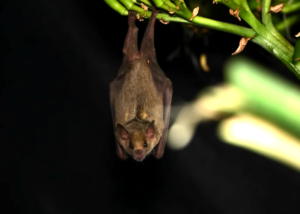
Nectar-feeding bats (like this Mexican long-nosed bat) and agaves have a mutualistic relationship. Pregnant bats are dependent on nectar corridors to make their annual migratory journeys between central Mexico and the U.S. Southwest to give birth to a single pup; in turn, they provide pollination services to agaves. Photo by Horizonline Pictures, Bat Conservation International.
Agaves also support biodiversity and are the lifeblood for three species of nectar-feeding bats. The Endangered Mexican long-nosed bat (Leptonycteris nivalis), the Lesser long-nosed bat (Leptonycteris yerbabuenae), and the Mexican long-tongued bat (Choeronycteris mexicana) depend on nectar corridors of agaves and other blooming vegetation to satisfy their annual migratory reproduction cycles. Females migrate annually from central Mexico north into Arizona, New Mexico, and Texas in the spring and summer, sometimes traveling more than 750 miles to give birth to a single pup. The bats depend on the distribution of different species of agaves that bloom at different times of year, which essentially form latitudinal migratory nectar corridors. Agaves are especially critical in northern Mexico and the American Southwest where Mexican long-nosed bat moms rely on agave plants as their only known nectar source. Agaves, in turn, depend on migratory bats to pick up and disperse pollen as they feed to assure the sexual reproduction of the plants and maintain healthy gene flow within agave populations, ultimately strengthening the plants’ resilience to climate change.
Unfortunately, climate change, wildfires, and the impacts of human development such as unsustainable ranching, agricultural expansion and intensification, and in some areas unsustainable agave harvest have degraded agave populations, fragmented the bats’ migratory agave corridors, and altered agave flowering schedules and put millions of acres of native ecosystems in grave peril and these three species of bats at risk.
In 1998, the U.S. Fish and Wildlife Service recognized the vulnerabilities of the Mexican long-nosed bat and listed it as Endangered in the United States under the Endangered Species Act. Within one to two decades, Mexican long-nosed bat populations are estimated to have declined by 50 percent, causing the International Union for the Conservation of Nature (IUCN) to add the species to the global Red List of endangered species and Mexico to recognize the species as Threatened. The Mexican long-nosed bat U.S. Recovery Plan identifies restoration of forage resources, particularly agave plants, as a priority action for recovery of the species. Restoration of agaves across the American Southwest and Mexico also supports recovery of the Lesser long-nosed bat (which was removed from the U.S. endangered species list in 2018) and the Mexican long-tongued bat.
* * * *
Spring 2023. Tonight, we’ve been invited to the home of Osvaldo Coronado for dinner. As Osvaldo grills, his wife Ana brings plates of food to a long table on the veranda. Osvaldo and his family-run business offer a real-world example of how agave farming through sound conservation practices supports livelihoods and a sustainable future. Osvaldo has become an ardent advocate for the partnerships formed through the Agave Restoration Initiative. Tonight, as I listen to the animated dinner table conversation, I look beyond the gathering as the setting sun silhouettes acres of spikey agaves. I’m looking for bats as the sky darkens.
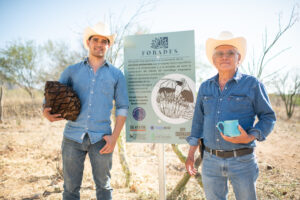
Agaves have a long ethnobotanical history in religion and Mexican culture and are important resources for rural communities, ranchers, and producers like Osvaldo Coronado and his family. Photo by Horizonline Pictures, Bat Conservation International.
In the State of Sonora in the northwest region of Mexico, Osvaldo Coronado and his family produce 200 liters of bacanora each year from the jumble of agaves they have planted on their property and the wild agaves that have grown on land Osvaldo’s family has owned for generations.
Osvaldo and his family understand the important role that nectar-feeding bats play in supporting healthy agaves and their livelihoods. They are now planting agaves for bats and allowing some of their crop go to flower to feed these bats. They are a significant part of the burgeoning success of the Agave Restoration Initiative, a bi-national landscape-scale initiative to save corridors of blooming agaves and native vegetation in Mexico and the American Southwest.
The Agave Restoration Initiative and landscape-scale collaboration
What began in 2018 with the planting of a few hundred agaves in Arizona by Bat Conservation International has grown immensely over the last seven years. Recognizing the need for coordinated, landscape-scale action to ensure recovery of these long-distance migratory bats, we have sought out and strengthened bi-national relationships and established best-practices for agave seed collection, propagation, and planting. We focused on public education and outreach, and supported pilot programs across several U.S. and Mexican states (Arizona, New Mexico, Coahuila, Nuevo León, and Sonora), eventually linking all into a coordinated large-scale bi-national conservation model: the Agave Restoration Initiative. As of January 2025, the Agave Restoration Initiative has expanded the geographic range to nine U.S. and Mexican states (adding Texas, Chihuahua, San Luis Potosí, and Zacatecas to the range); planted over 116,000 agaves; protected or restored over 13,500 acres; built or supported 26 community and private nurseries for production of native agave plants for restoration efforts and production of other locally-important plants; supported 12 community and private green businesses, including seven women-owned businesses; trained over 180 community members in sustainable agricultural and ranching techniques; created over 250 local employment opportunities through restoration activities; engaged 130 community members and landowners in “exchanges of experience” to foster skill and knowledge sharing; reached over 1.5 million people locally and worldwide through educational programming about bats and agaves; produced two children’s books (Spanish) highlighting bat and agave conservation; and launched three regional agave restoration networks to guide restoration actions.
A landscape of agaves requires patience, pollinators, and partners
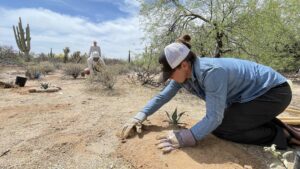
Agaves are planted after 2-3 years of growing in partner nurseries. Photo by Kristen Lear, Bat Conservation International.
From seeds, agaves can take as long as three years to grow before they are ready for planting. Fledgling agaves are often planted with fist-size rocks piled around the base of the plant to protect the plant and its offshoot, called a pup, from being devoured by desert rodents and wildlife. A splash of water can give the pups a helping hand especially in drier times. Then, there is the wait.
Agaves generally bloom after five to 20 years (or longer) – depending on species, climate, soil, water, and other growing conditions – and then the plant dies in what might be called a suicidal event. Bats serve a critical role in dispersing pollen from the blooming agaves – when the agaves are in the throes of dying – to keep plant growth cycles going. Here is where the natural process can go awry. Harvest of agaves for making tequila, mezcal, and bacanora typically involves cutting off the stalk of the agave plant before it gets tall or preventing growth of the stalk in the first place to keep sugars in the base of the plant. The capón (cutting) removes the blooms that attract and feed bats which, in turn, diminishes the number of bats available to pollinate the plants.
Dr. Ana Ibarra, Bat Conservation International’s Regional Director for Mexico & Latin America, travels thousands of miles each year to monitor bat roosts and to work with communities, conservation groups, and landowners like Osvaldo and his family to implement agave harvest and land management practices that support bats and general ecosystem health. Valeria Cañedo and staff from the organization Polinizador Social para la Conservacion y Empoderamiento Rural (formerly Colectivo Sonora Silvestre) also travel through the countryside meeting with producers of agave-derived spirits to improve ways of agave harvesting and ecological management.
Farmer-harvesters like Osvaldo and his family have honed sustainable agave planting, harvesting, and production practices. A significant part of his family’s success is, Osvaldo says, “respecting where our good fortune comes from.” He adds: “Agaves and bats give us more than a drink, they give us our way of life. We’ve become more than farmers. We’ve become conservationists.”
* * * *
Data, building trust, and sustainable practices
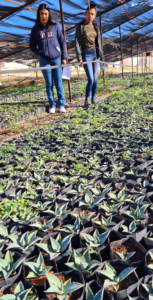
Native agaves growing in a nursery in a southern Nuevo León ejido. Photo by Nahum Sanchez.
Preserving the vast landscapes of Mexico and the American Southwest depends on building trust among communities and demonstrating that sustainable practices have short- and long-term benefits, says Dr. José Juan Flores-Maldonado, Executive Director of local NGO Especies, Sociedad y Hábitat, A.C. in Monterrey, Mexico. With over 20 scientific publications to his name and more than 60 citations in other scientific reports, Dr. Flores-Maldonado is well known and respected for guiding important land management decision-making throughout Mexico.
Ten years ago, Dr. Emma Gómez-Ruiz, a well-known bat researcher in Mexico, invited Dr. Flores-Maldonado to help identify roost sites for a bat species in northeastern Mexico. The project, he says, hooked him into developing education and outreach strategies to promote conservation and community planning processes that help sustain rural communities, wildlife, and vegetation.
In 2021, Dr. Flores Maldonado, Dr. Gómez-Ruiz, and other scientists published an analysis of land use changes in northeastern Mexico that noted landscape fragmentation and loss of foraging habitat. Since then, there have been wildfires that have impacted more than 50,000 acres of vital bat habitat. Addressing these issues is critical to Mexico’s future, Dr. Flores-Maldonado says.
Dr. Flores-Maldonado meets with ranchers in rural communities. His advocacy is direct: agaves are part of Mexico’s cattle ranching history, past and present. As drought conditions worsen, due to climate change, the extending root systems of agaves are going to be crucial to Mexico’s future, he says.
“Particularly in the areas where we work, we face the challenges of poverty reduction and the recovery of severely degraded areas. Both issues are closely linked, so the search for productive options that guarantee the improvement of the quality of life, while gradually recovering ecosystem functions and biodiversity, are the most urgent topics to address,” says Dr. Flores-Maldonado. “Paradigm change towards sustainable models is our goal.”
Success is based, he says, on transparent communication with farmers and ranchers and strategic partnerships. Dr. Flores-Maldonado says collaboration with agencies such as the Cuenca Don Martín Protected Area of Mexico’s National Commission of Protected Natural Areas and Bat Conservation International is key to a sustainable future.
Agave plantings, poverty reduction, and the short- and long-term future
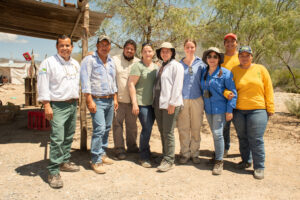
Dr. José Juan Flores-Maldonado (third from left), Dr. Ana Ibarra (fourth from left), Dr. Emma Gómez-Ruiz (fifth from left), and Dr. Kristen Lear (sixth from left) with local community and government partners in Coahuila. Photo by Horizonline Pictures, Bat Conservation International.
The Agave Restoration Initiative has been working with partners like Osvaldo and his family, Dr. Flores-Maldonado, and Dr. Gómez-Ruiz to establish sustainable land management solutions for bats and people. Examples of the Agave Restoration Initiative’s project-based sustainability mechanisms include prioritizing agave plantings in projected climate strongholds for nectar-feeding bats and agaves and pairing our agave plantings with broader habitat, watershed, and soil restoration activities whenever possible. We’re employing adaptive management tactics for our restoration work and continuing our priority for monitoring and data collection. We’re working to build local capacity for sustainable land management and sustainable rural economies through collaborative project development, technical training in topics such as regenerative agriculture and ranching and agave restoration, and local and regional peer-to-peer learning opportunities.
We are holding the initiative to high standards. We expect our work to not only support biodiversity conservation, but also support the diversification of livelihoods, to enhance local food security, and to provide technical training and job opportunities. We also expect to reclaim degraded lands.
Key to the long-term success of saving this massive cross-border landscape is educating stakeholders to the urgency of taking small but significant steps now to adopt sustainable land management practices and effectively encouraging stakeholders to re-vegetate corridors now before it is too late. Long-term success is unquestionably dependent on building localized networks and uniting networks into a guiding bi-national initiative. Moreover, short-term benefits must be recognized.
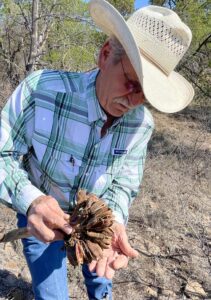
A land manager in the Trans-Pecos of Texas collecting agave seeds for restoration efforts. Photo by Kristen Lear, Bat Conservation International.
As the Agave Restoration Initiative continues to expand, at least 50 rural communities and landowners in Mexico and the U.S. are expected to benefit. Work with these communities and landowners includes collecting native seeds, growing agaves in community and private greenhouses, planting and monitoring agaves, restoring degraded lands, designating livestock exclusion areas, supporting community green businesses, and developing best management practices for ranching that supports agave populations.
Additionally, we are employing conservation technology such as drones, satellite imagery, camera traps, and environmental DNA (eDNA) as well as developing citizen science and community monitoring programs to monitor nectar-feeding bat roosts and identify migratory corridors and range expansion areas. We have already made important discoveries with these approaches, including recording the first confirmed occurrence of the Mexican long-nosed bat in Arizona through our nectar-feeding bat eDNA survey methodology.
The Agave Restoration Initiative’s long-term goals are, admittedly, ambitious, with impacts across ecological, social, and economic realms. What we have found is that it is essential to pursue such complex, interconnected goals through diverse, multi-sectoral partnerships. Currently, the initiative brings together over 65 partners including bat and agave experts, local communities and private landowners, environmental and education non-profits and civil society organizations, government agencies, private industry, schools and universities, and public interest groups in the U.S. and Mexico. A bi-national and multidisciplinary approach allows us to set ambitious goals that enhance climate resiliency and sustainability – for both natural and human communities.
* * * *
Over the past seven years, we’ve learned that education and engagement tactics must be customized to location and that building trust takes invested time and intention, and requires continual maintenance. We’ve learned that being equitable in partnerships mandates paying attention to see that benefits are dispersed as equitably as possible. We’ve found that getting beyond language differences and barriers is not insurmountable. All of that has moved forward with a vision of working toward a common goal and the commitment to support each other.
As we reflect on these seven years, we see a series of factors that strike us as being broadly relevant to the success of landscape conservation and stewardship activities. These factors include:
- Coordinating action at the scales needed for success. To address the urgent needs of these long-distance migratory bat species and the fragile ecosystems on which they depend, conservation actions must implement coordinated, landscape-level changes benefiting entire ecosystems rather than focusing only on individual species. Conservation of these species also requires long-term, committed action.
- Employing a climate-informed approach to bolster climate resiliency. We are conducting climate change-driven planning to ensure our actions are climate-informed for long-term impact. We are restoring agaves within current migratory corridors, and are also using climate modeling for agaves and nectar bats to identify areas that are expected to become range expansion areas or “climate refugia.” By doing this, we can ensure that there are sufficient foraging resources for these bats long into the future.
- Collaborating and layering our conservation efforts within other conservation programs. In Mexico, we’re working with various federal and state agencies, including the Comisión Nacional de Áreas Naturales Protegidas (CONANP) and the Secretaría del Medio Ambiente de Nuevo León to scale up agave restoration activities in the most efficient manner to meet state and national biodiversity and sustainable development priorities. In the U.S., we’re engaged in 30×30 goals to protect 30 percent of America’s natural areas by 2030, and are fully behind efforts to protect and restore ecologically important lands in the American Southwest.
- Contributing to global sustainability through bat conservation. The Agave Restoration Initiative works at the intersection of bat conservation and sustainable rural development to address the global environmental and socio-economic challenges of biodiversity loss, land degradation, poverty, and inequality. We address these issues through an integrative, inclusive approach to nature-based solutions that includes restoration of agave plants that have immense environmental, cultural, and economic value; participatory development of community-based sustainable land management plans and sustainable community businesses; and local capacity building, ultimately catalyzing community and institutional empowerment for conservation and restoration across a large bi-national landscape. The Agave Restoration Initiative contributes to 15 of the U.N.’s 17 Sustainable Development Goals, including Goal 1 (No Poverty), Goal 2 (Zero Hunger), Goal 13 (Climate Action), and Goal 15 (Life on Land).
- Concentrating on mutually benefiting relationships and partnerships. Success is notably attributable to diverse relationships and partnerships. Our diverse partners come from many different backgrounds and lived experiences. This diversity brings strength to the work, and we commit to listening to the diverse voices and perspectives that are brought to the table.
- Educating the broad public about the importance of bats and the mutualistic relationships between bats and agaves and enhance local capacity for agave restoration and bat conservation. Bat Conservation International engaged an award-winning videographer to produce a series of videos on this work and created the “We Belong Together” web campaign to highlight these video and the stories of the bats and the people working to restore healthy ecosystems.
Because the socio-ecological issues the Agave Restoration Initiative addresses are large-scale priority issues across Mexico and the U.S. Southwest, we envision immense opportunities to integrate our conservation goals with current governmental, agricultural, sustainable development, and climate resilience programs. We welcome the support from landscape managers around the world, and invite you to share experiences in developing and implementing large landscape-scale initiatives that support biodiversity conservation and rural livelihoods.

Flowering agave in Big Bend National Park. Photo by Kristen Lear, Bat Conservation International.
* * * *
COMPANION WEBINAR: Colleagues from Bat Conservation International will join us for a webinar, Expanding community-based conservation pilots to a large-scale landscape conservation program: Conservation of an agave corridor for bats and people in northeast Mexico, on Tuesday, April 29 at 2PM ET, to more deeply explore the Agave Restoration Initiative and the insights that have emerged over the last seven years.
The development of this webinar presentation and the associated work has been supported by the Salazar Center for North American Conservation’s Peregrine Accelerator for Conservation Impact, the Center for Collaborative Conservation’s Fellows Program, and the 2023 International Land Conservation Network Academy.
# # # #
About Kristen Lear, Ph.D.: As Agave Restoration Program Director for Bat Conservation International, Dr. Lear’s responsibilities entail managing a variety of strategies for sustaining migratory bats and corridors of agaves across thousands of acres from central Mexico north into the U.S. Southwest. Over the past seven years, the bi-national Agave Restoration Initiative has become a model of integrative conservation solutions and sustainability strategies. Dr. Lear earned a B.A. in Zoology from Ohio Wesleyan University where she studied the pest control services bats provide in Texas pecan orchards. She also led a bat house study for her Honors research. Following graduation, she earned a Fulbright Scholarship to study the critically endangered Southern bent-wing bat (Miniopterus schreibersii bassanii) in South Australia. In 2020, Kristen earned her Ph.D. in Integrative Conservation from the University of Georgia. Her Ph.D. work combined natural and social science approaches to aid in the conservation of the endangered Mexican long-nosed bat (Leptonycteris nivalis) in northeast Mexico.
